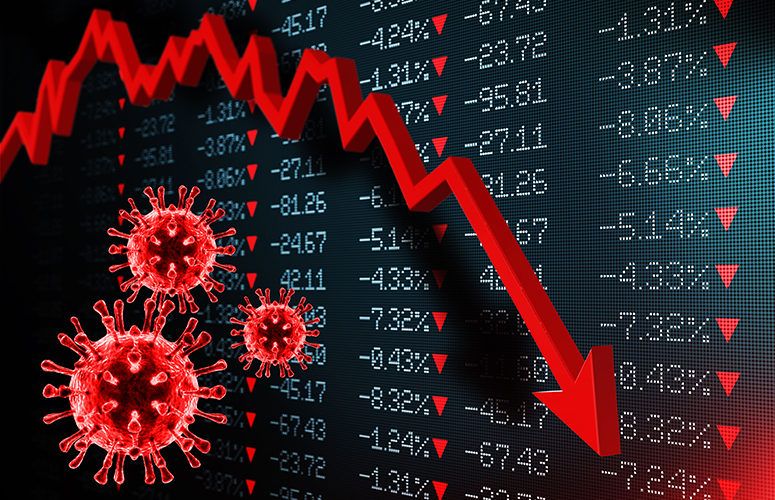COVID-19 is a virus that can cause a variety of symptoms, including death, in people who have it. Getting vaccinated, wearing a mask, staying 6 feet away, washing hands often, and avoiding sick persons are the best preventive methods.
Coronaviruses are a type of virus that can infect humans and cause respiratory disease. They’re nicknamed “corona” because the virus’s surface has crown-like spikes. Coronaviruses that cause sickness in humans include SARS, Middle East respiratory syndrome (MERS), and the common cold.

COVID-19, a novel coronavirus strain, was initially discovered in Wuhan, China, in December 2019. Since then, the virus has spread to every continent.
The Current Scenario:
A sudden upsurge has been witnessed recently when havoc let loose on the Indian economy for the 2nd time. As the economy was just trying to get back on track, after the devastating effect brought by the first wave of the Pandemic which had broken out around the globe shortly after the World Health Organization called the Novel Coronavirus to outbreak a pandemic. In this second phase, the localised lockdowns have harmed a number of retail and wholesale businesses, but the fact that products are still being moved and industries are being allowed to operate can help to mitigate the economic losses.
The effect on industrial production during the second wave is lower than the devastation seen in 2020, according to CRISIL. The current second wave will only result in a “short-term negative economic shock,” it said, adding that the medium-term growth outlook remains stable.
Another encouraging sign for the economy is the possibility that the second wave of Covid-19 will peak within the next 20 days. India’s largest public lender, the State Bank of India, made the forecast.
India will hit its second peak
“Based on the experience of other countries, we believe India will hit its second peak when the recovery rate reaches 77.8%,” the SBI report said.
According to the SBI study, India could reach its peak by mid-May, after which active cases could begin to decline if all precautions are strictly followed. Adult vaccinations, which begin on May 1, will also help to prevent further infections.
In such circumstances, India’s economic growth is likely to be slowed in the near future. However, it also ensures that businesses will not be disrupted for several quarters.
The large scale vaccination drive initiated by the government of India has boosted the economy to a great extent.
While most analysts believe the second wave’s effect on the economy would be less severe than last year’s, there are many threats that could derail the economy. Rising income inequality, unemployment, sectoral effect, consumer confidence, and inflation are just a few of them.
Multiple brokerages and rating agencies have revised India’s GDP downward as a result of this.
Although the second wave has had little effect on salaried workers’ livelihoods, it has once again impacted poorer households. When some states declared lockdowns in major cities, tens of thousands of migrant workers and daily wage workers returned home.
The second wave is more India-centric
The second wave is more India-centric. During the first wave, we had observed that the clampdowns were implemented both inside and outside India, according to credit rating agency CRISIL, “which will curb customer mobility and contribute to deferred spending.” Although we expect most industries not to be effected on a large scale, this credit warning focuses on those that will be at the forefront of the pandemic’s disruption.”
The coronavirus epidemic has had an effect on both financial markets and consumer sentiment, and with continuing liquidity problems and lockout situations, it appears that financial institutions are in for more trouble.
Following the IL&FS crisis, India’s NBFCs are experiencing a liquidity crunch. NBFCs rely on banks for liquidity, and any weakness in bank deposit funding will limit the amount of money available for lending to the shadow banking sector.
With the coronavirus looming over us, the NBFC sector has already begun to experience more problems. According to a Fitch report, the effect of the novel coronavirus outbreak poses additional threats to economic growth and the asset quality of non-bank financial institutions. It will be difficult for the non-banking sector to fulfil its asset quality requirements if NBFC customers –MSMEs, who is a critical pillar of an emerging economy like India — are unable to do business as usual.
As a result, the economic downturn caused by the coronavirus would have an effect on loan demand, reducing NBFC income even further.

The Effect of the First wave
According to a study published by S&P Global Ratings, demand had collapsed drastically threatening a cash flow crisis. Central banks avoided structural collapses in the financial system by lowering interest rates to zero or below, injecting liquidity into the system, and introducing risk-mitigation steps similar to those implemented after the global financial crisis.”
The government has already begun taking fiscal steps to control the health situation and prevent COVID-19 from wreaking havoc on the population. The duration of the crisis, the country’s economic and political stability, and the pace and adequacy of policy responses will all play a role in the trajectory of sovereign ratings, as observed by S&P.
Fintechs will see a decrease in funding for both current and new fintech companies. The dry spell is expected to last for the next few years, prompting analysts to conclude that these companies should concentrate more on long-term growth models rather than relying on investors’ funds.
Fintechs that fund trade, for example, are seeing their sales suffer while the overall trade suffers. The exchange is being impacted by both the supply and demand sides of the equation.
It has been observed that during a global recession, a drop in sales will place pressure on a company’s day-to-day operations, which can have a long-term effect on the company.
Also in the world’s strongest economies, the economic shocks are still visible. Central banks have launched unprecedented stimulus packages, interest rates are at historic lows in many major markets, and governments have announced unprecedented support initiatives. Even getting back to something like economic stability could take a long time.
In coping with the effects of COVID-19 and the increasingly stringent containment measures that policymakers are putting in place, financial services sector leaders around the world are constantly focusing on six main challenges.
#1 Those who work for you
The way you handle your workers now would have a significant impact on their happiness, and therefore their loyalty and productivity. Make it clear that you accept any adjustments they need to make to their work schedules or performance goals in order to fulfil their obligations to their families and communities. Be a champion of good citizenship, and where possible, promote containment and home-working.
Financial services firms around the world are making substantial adjustments to their operating arrangements, in some cases consulting with regulators to ensure that they satisfy regulatory requirements, and this is allowing them to continue to provide services to their clients.
#2 Clientele:
Business customers in heavily affected countries are facing urgent needs as sales are interrupted, while hardworking people’s wages are threatened on a personal level. Financial institutions play a more critical role than ever before in offering liquidity, funding, and essential forbearance to individual customers who are experiencing temporary difficulties. It’s also important that they have constant assurances about service continuity. Customers also want to know how their providers handle issues like health and travel insurance, investment fund results, and online payment options, which are all directly related to COVID-19.
#3 Availability of liquid assets:

Financial services firms must have a clear understanding of their available capital and liquidity tools, as well as their resilience. To counteract a larger, systemic liquidity crunch, central banks have been delivering massive stimulus packages. Although this lowers borrowing rates, it also raises the likelihood that some firms will stockpile cash and open credit lines to get through the crisis.
#4 Relationships with suppliers and reliance on third parties:
Vendors (including in-person agent networks), outsourcing partners, infrastructure suppliers, and other third-party networks are all essential to financial services firms (and their customers).
They must evaluate and track these third parties on a regular basis in terms of information security, business continuity, and other risk domains. Companies must determine the suppliers are most likely to be affected, which are essential to continuing business operations, and where they must immediately minimise risks faced by these relationships as a result of the COVID-19 effect.
#5 Transparency and communication:
Financial services firms will need to ensure that they are engaging successfully with various stakeholders, including staff, consumers, shareholders, and regulators, as the market and economic impacts of COVID-19 begin to bite. The situation is fertile ground for misinformation and rumour, so financial institutions should be cautious, they must be transparent about the steps they are taking to mitigate the effects of COVID-19. Financial services firms are expected to concentrate on and maintain the continuity of their core activities, including customer care, according to regulators. Financial services firms must evaluate their digital communication capabilities on a regular basis, as well as how to use them to engage with consumers and the wider market.
#6 Planning scenarios:
Financial services firms are in the business of imagining the future, which includes recognising the major immediate challenges presented by COVID-19 to society and economies, as well as the implications for the integrated financial system. They’re using their experience in scenario modelling and crisis planning to assist themselves and their customers in making sound decisions in a highly unpredictable operating environment. They would also need to integrate new metrics into their decision-making processes, which have been prioritised by the COVID-19 outbreak.
In conclusion:
The COVID-19 pandemic is a global stressor that is putting environmental, operational, and commercial resilience to the test for all companies. In this context, the financial services industry must adjust to current constraints and market dynamics quickly and at scale.
To date, businesses have logically prioritised urgent financial and operational steps such as protecting liquidity and cash flows, as well as ensuring that core business operations can continue.
Financial regulators have taken measures to relieve the burden on firms’ finances by deferring high-impact practices such as stress tests, lowering capital reserves, and driving out the impasse. Wherever necessary, push back implementation dates and postpone non-critical supervisory reviews.
When companies come to terms with handling fragmented workforces, we expect to see a change in emphasis and a re-prioritization of organisational and behaviour risks.
Originally posted 2021-05-18 12:01:58.







Pingback: Is Nudity still a Taboo? The Culture, History and the Art surrounding Nudity
Pingback: Restaurant and Food Joints having a tough time due to the Covid -19
Pingback: The Decline Of Indian National Congress - The Rahul Gandhi Card.